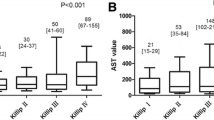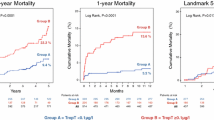Summary
Background
In patients with ST-elevation myocardial infarction (STEMI), the relationship between transaminases and myocardial damage detected by cardiac magnetic resonance (CMR) imaging is unknown and the prognostic value incompletely investigated.
Materials and methods
CMR imaging was performed in 167 STEMI patients 2.3 [1.6–3.9] days after primary percutaneous coronary intervention (PPCI). Blood samples for transaminase measurement (aspartate transaminase (AST) and alanine transaminase (ALT)) were obtained serially from day 1 to day 4 after PPCI. Patients were followed for major adverse cardiac events (MACE) for 2.7 [1.1–3.3] years.
Results
Admission and peak concentrations of AST and ALT were significantly associated with ejection fraction (p < 0.001), infarct size (p < 0.001), and the presence of microvascular obstruction (p < 0.01). Peak values of both transaminases showed a stronger correlation with CMR parameters than admission values (all p < 0.05). In Kaplan–Meier analysis, a high peak AST or high peak ALT was associated with reduced MACE-free survival (both p < 0.01), whereas admission values were not (both p > 0.05). Peak AST (hazard ratio (HR): 4.93 [1.70–14.32], p = 0.003) and peak ALT (HR: 5.67 [1.94–16.56], p = 0.002) were independent predictors of MACE after adjusting for clinical risk factors.
Conclusions
Transaminases measured in the acute phase after PPCI for STEMI are associated with systolic dysfunction, more extensive myocardial necrosis and microvascular injury with subsequent prognostic information on MACE at long-term follow-up.




Similar content being viewed by others
References
Jernberg T, Johanson P, Held C, Svennblad B, Lindback J, Wallentin L, Swedeheart/Riks HIA. Association between adoption of evidence-based treatment and survival for patients with ST-elevation myocardial infarction. JAMA. 2011;305:1677–84.
Steg PG, James SK, Atar D, Badano LP, Blomstrom-Lundqvist C, Borger MA, Di Mario C, Dickstein K, Ducrocq G, Fernandez-Aviles F, Gershlick AH, Giannuzzi P, Halvorsen S, Huber K, Juni P, Kastrati A, Knuuti J, Lenzen MJ, Mahaffey KW, Valgimigli M, van ’t Hoff A, Widimsky P, Zahger D. ESC Guidelines for the management of acute myocardial infarction in patients presenting with ST-segment elevation. Eur Heart J. 2012;33:2569–619.
Mueller C. Biomarkers and acute coronary syndromes: an update. Eur Heart J. 2014;35:552–6.
Chinsky M, Shmagranoff GL, Sherry S. Serum transaminase activity; observations in a large group of patients. J Lab Clin Med. 1956;47:108–18.
Lofthus DM, Stevens SR, Armstrong PW, Granger CB, Mahaffey KW. Pattern of liver enzyme elevations in acute ST-elevation myocardial infarction. Coron Artery Dis. 2012;23:22–30.
Lazzeri C, Valente S, Tarquini R, Chiostri M, Picariello C, Gensini GF. Prognostic values of admission transaminases in ST-elevation myocardial infarction submitted to primary angioplasty. Med Sci Monit. 2010;16:567–74.
Moon J, Kang W, Oh PC, Seo SY, Lee K, Han SH, Ahn T, Shin E. Serum transaminase determined in the emergency room predicts outcomes in patients with acute ST-segment elevation myocardial infarction who undergo primary percutaneous coronary intervention. Int J Cardiol. 2014;177:442–7.
Lazzeri C, Valente S, Boddi M, Mecarocci V, Chiostri M, Gensini GF. Clinical and prognostic significance of increased liver enzymes in ST-elevation myocardial infarction. Int J Cardiol. 2014;177:543–4.
Klug G, Mayr A, Schenk S, Esterhammer R, Schocke M, Nocker M, Jaschke W, Pachinger O, Metzler B. Prognostic value at 5 years of microvascular obstruction after acute myocardial infarction assessed by cardiovascular magnetic resonance. J Cardiovasc Magn Reson. 2012;14:46.
Eitel I, de Waha S, Wohrle J, Fuernau G, Lurz P, Pauschinger M, Desch S, Schuler G, Thiele H. Comprehensive prognosis assessment by CMR imaging after ST-segment elevation myocardial infarction. J Am Coll Cardiol. 2014;64:1217–26.
de Waha S, Desch S, Eitel I, Fuernau G, Lurz P, Leuschner A, Grothoff M, Gutberlet M, Schuler G, Thiele H. Relationship and prognostic value of microvascular obstruction and infarct size in ST-elevation myocardial infarction as visualized by magnetic resonance imaging. Clin Res Cardiol. 2012;101:487–95.
Klug G, Metzler B. Assessing myocardial recovery following ST-segment elevation myocardial infarction: short- and long-term perspectives using cardiovascular magnetic resonance. Expert Rev Cardiovasc Ther. 2013;11:203–19.
Alpert JS, Thygesen K, Antman E, Bassand JP. Myocardial infarction redefined–a consensus document of The Joint European Society of Cardiology/American College of Cardiology Committee for the redefinition of myocardial infarction. Eur Heart J. 2000;21:1502–13.
Reinstadler SJ, Klug G, Feistritzer HJ, Mayr A, Harrasser B, Mair J, Bader K, Streil K, Hammerer-Lercher A, Esterhammer R, Metzler B. Association of copeptin with myocardial infarct size and myocardial function after ST segment elevation myocardial infarction. Heart. 2013;99:1525–9.
Klug G, Trieb T, Schocke M, Nocker M, Skalla E, Mayr A, Nowosielski M, Pedarnig K, Bartel T, Moes N, Pachinger O, Metzler B. Quantification of regional functional improvement of infarcted myocardium after primary PTCA by contrast-enhanced magnetic resonance imaging. J Magn Reson Imaging. 2009;29:298–304.
Bondarenko O, Beek AM, Hofman MB, Kuhl HP, Twisk JW, van Dockum WG, Visser CA, van Rossum AC. Standardizing the definition of hyperenhancement in the quantitative assessment of infarct size and myocardial viability using delayed contrast-enhanced CMR. J Cardiovasc Magn Reson. 2005;7:481–5.
Mayr A, Klug G, Schocke M, Trieb T, Mair J, Pedarnig K, Pachinger O, Jaschke W, Metzler B. Late microvascular obstruction after acute myocardial infarction: relation with cardiac and inflammatory markers. Int J Cardiol. 2012;157:391–6.
Reinstadler SJ, Klug G, Feistritzer HJ, Mayr A, Bader K, Mair J, Esterhammer R, Schocke M, Metzler B. Relation of plasma adiponectin levels and aortic stiffness after acute ST-segment elevation myocardial infarction. Eur Heart J Acute Cardiovasc Care. 2014;3:10–7.
Hosmer DW, Lemeshow S. Applied survival analysis: regression modeling of time to event data. New York: Wiley; 1999.
Karmen A, Wroblewski F, Ladue JS. Transaminase activity in human blood. J Clin Invest. 1955;34:126–31.
Giesen PL, Peltenburg HG, de Zwaan C, Janson PC, Flendrig JG, Hermens WT. Greater than expected alanine aminotransferase activities in plasma and in hearts of patients with acute myocardial infarction. Clin Chem. 1989;35:279–83.
Lindblom P, Rafter I, Copley C, Andersson U, Hedberg JJ, Berg AL, Samuelsson A, Hellmold H, Cotgreave I, Glinghammar B. Isoforms of alanine aminotransferases in human tissues and serum–differential tissue expression using novel antibodies. Arch Biochem Biophys. 2007;466:66–77.
Author information
Authors and Affiliations
Corresponding author
Rights and permissions
About this article
Cite this article
Reinstadler, S., Reindl, M., Feistritzer, HJ. et al. Prognostic significance of transaminases after acute ST-elevation myocardial infarction: insights from a cardiac magnetic resonance study. Wien Klin Wochenschr 127, 843–850 (2015). https://doi.org/10.1007/s00508-015-0868-6
Received:
Accepted:
Published:
Issue Date:
DOI: https://doi.org/10.1007/s00508-015-0868-6




